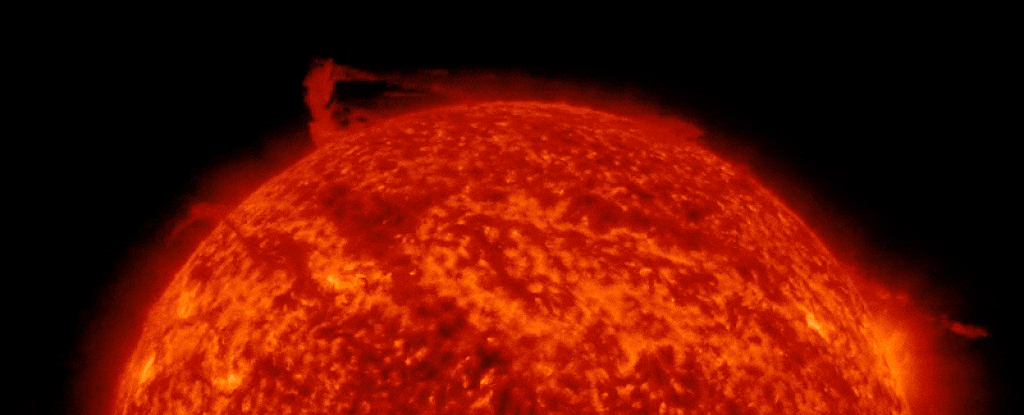For all that the Sun is a ubiquitous and vital part of our lives, a lot about it remains baffling. And now it's done something decidedly peculiar.
Material from a filament of plasma erupting from the Sun's surface broke away and appeared to form a crown-like vortex over the solar north pole.
Further analysis will be required to determine whether or not this is what actually occurred.
For now, scientists are saying that they've not quite seen anything like it – and the footage itself is undoubtedly spectacular.
Talk about Polar Vortex! Material from a northern prominence just broke away from the main filament & is now circulating in a massive polar vortex around the north pole of our Star. Implications for understanding the Sun's atmospheric dynamics above 55° here cannot be overstated! pic.twitter.com/1SKhunaXvP
— Dr. Tamitha Skov (@TamithaSkov) February 2, 2023
Solar shenanigans are not entirely unexpected currently. Our star is ramping up its activity, getting rowdier with sunspot and flare activity. It has flared every day this year so far, and it spat out several X-class and M-class flares in January 2023, the biggest and second-biggest eruptions the Sun is capable of.
This is nothing to be alarmed about. The Sun undergoes activity cycles every 11 or so years, from relatively quiet and peaceful, to absolutely rambunctious.
These cycles coincide with fluctuations in the solar magnetic field. When the magnetic field is at its weakest at the poles, the Sun's magnetic poles switch places, and the polarity of the magnetic field reverses. This is when the Sun is at its most active, known as solar maximum.
Yes, an amazing vortex motion in Sun's north polar region. This animation is made of combined AIA 171 Å + 304 Å images, showing the dynamic cool material in the background corona. https://t.co/OApfBUL9qf pic.twitter.com/ID4TYIw23p
— Halo CME (@halocme) February 3, 2023
We're right on the cusp of solar maximum. Because the Sun is so enigmatic and difficult to predict, we don't know precisely when the polarity reversal will occur (scientists can usually only make a ruling after the event), but we do know a rough ballpark: Our current predictions place it in July 2025.
But the current cycle is also a bit strange. Not all solar cycles are built alike; some are stronger, some are weaker. Solar scientists can make predictions about the progression of the solar cycle ahead… but from very early on in the current cycle, which started in December 2019, the Sun's activity has significantly exceeded expectations and continues to do so.
More observations of the #SolarPolarVortex reveal it took roughly 8 hours for material to circumnavigate the pole at approximately 60° latitude. This means an upper bound in the estimation of horizontal wind speed in this event is 96 kilometers per second or 60 miles a second! pic.twitter.com/EpHhwdLeDs
— Dr. Tamitha Skov (@TamithaSkov) February 4, 2023
This brings us back to the weird little polar tizzy observed on 2 February. From what scientists can tell so far, it started with a solar prominence, a bright filament of plasma that extends outward from the surface of the Sun.
Not only are solar prominences normal, but so were the location and type of this particular one. A large "hedgerow" prominence – so named because it resembles a hedge – often occurs around the crown of the Sun, at high latitudes.
But what happened next was not: Material seemed to break away, circling the pole at 60 degrees latitude over about 8 hours, at a speed of about 96 kilometers (60 miles) per second.
Running diff pic.twitter.com/VyHiofdZpE
— Scott McIntosh (@swmcintosh) February 3, 2023
Solar physicist Scott McIntosh of the US National Center for Atmospheric Research – who has been observing the Sun for decades trying to understand its cycles – told Space.com that he had never seen a "vortex" like the one that occurred when a piece of the prominence broke away and was whipped into the solar atmosphere.
We'll have to wait to find out more about the strange event. Scientists are no doubt even now analyzing the wealth of data we have from round-the-clock solar observatories, so hopefully, that wait won't be too long. Because the solar poles are difficult to observe, the findings should be very interesting.
Meanwhile, the predictions of McIntosh and his team more closely match the observed solar cycle to date than any other prediction. You can read more about his work here.
